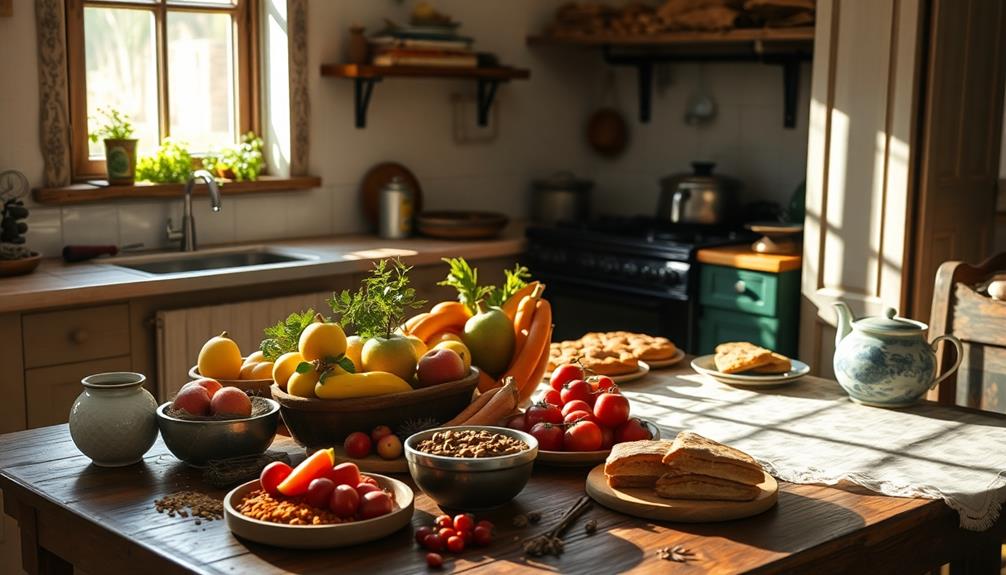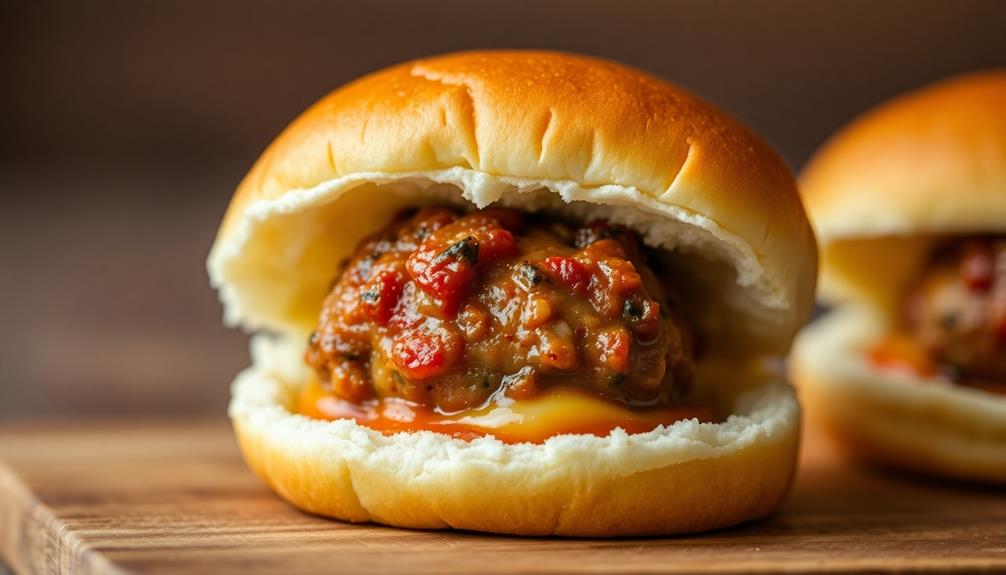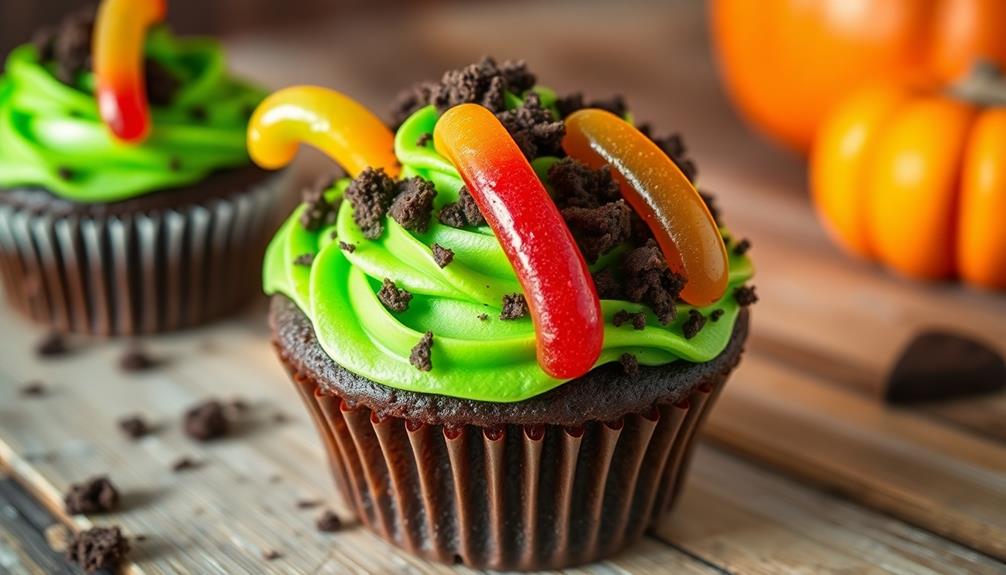Certain foods trigger sensory memories because they connect taste and smell with emotions. When you savor a dish, the aroma ignites vivid memories, thanks to your brain's hippocampus. This area links smells to past experiences, making flavors recall cherished moments, like childhood celebrations. Familiar tastes often enhance emotional responses, evoking nostalgia tied to family and culture. Additionally, the right context amplifies these memories, embedding them deeper in your mind. So, the next time you bite into a favorite treat, notice the memories it stirs. There's so much more to explore about this fascinating connection.
Key Takeaways
- The hippocampus links smell and taste to memories, creating strong emotional associations with specific foods.
- Over 80% of taste perception relies on smell, enhancing the flavor experience and memory recall.
- Familiar flavors and aromas from childhood evoke nostalgia and vivid memories of past experiences.
- Emotional contexts, such as celebrations or gatherings, deepen the significance of culinary memories.
- Unique smell profiles from homemade dishes trigger stronger emotional reactions than pre-packaged foods.
Emotional Power of Taste and Smell
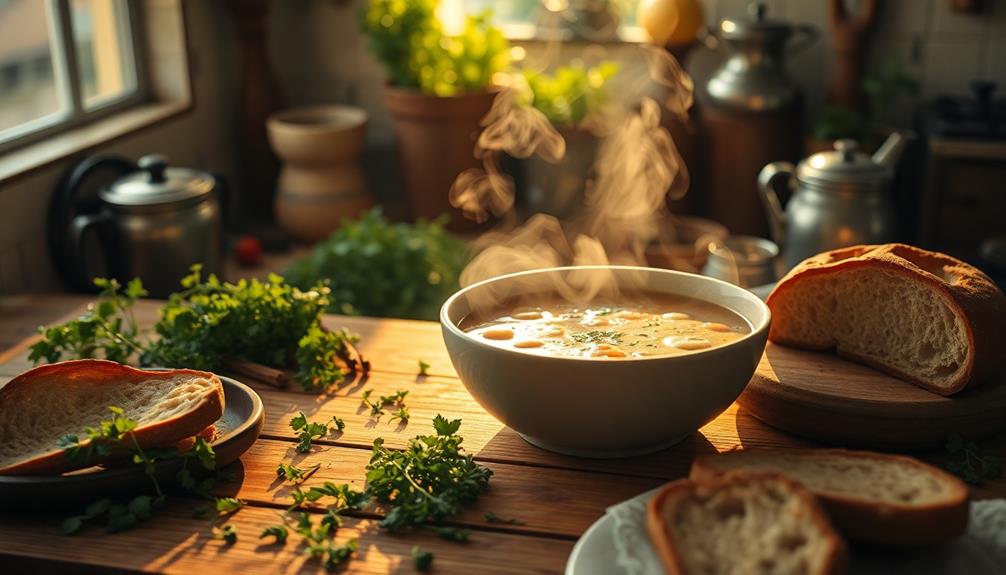
Connecting taste and smell, food can transport you back to cherished moments in your life. For instance, the aroma of freshly prepared Dorayaki (Red Bean Pancake) might evoke memories of childhood treats shared with family. You might find that a whiff of freshly baked bread or the taste of a family recipe brings vivid memories rushing back.
This emotional power stems from the hippocampus, which links those sensory experiences to strong memories. When you taste and smell simultaneously, you amplify your flavor perception, experiencing food on a deeper level.
Your tongue may detect basic flavors, but it's your olfactory system—housing over 12 million receptors—that reveals the subtle nuances of taste. This intricate pairing creates complex flavors that evoke visceral emotions. When you savor a specific dish, those flavors can trigger not just memories but also feelings tied to significant life events.
Through biological wiring, certain tastes and aromas become ingrained in your memory, making them powerful mediums for recalling past experiences. Every bite can activate emotional brain regions, reinforcing the connection between food and memories.
The Neuroscience Behind Food Memories
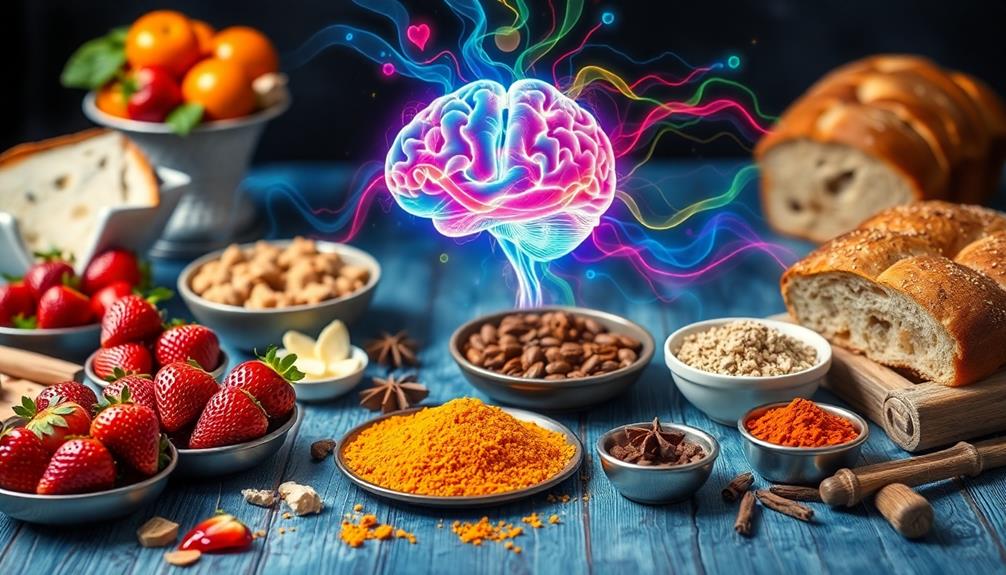
Food memories are intricately woven into the fabric of our brains, with the hippocampus serving as a crucial hub for storing these experiences. This region plays a critical role in forming long-term food-related memories, closely linked to the emotional responses and contexts tied to taste and smell.
For instance, the warm, comforting aroma of Kue Putu can evoke fond memories of family gatherings and celebrations. When you indulge in a sweet treat, like candy, your brain's reward centers activate, releasing dopamine. This process helps transform those fleeting moments into lasting food memories.
The olfactory system, with its over 12 million receptors, works hand-in-hand with your sense of taste to enhance flavor perception. Its proximity to the hippocampus allows emotional memories related to food to be encoded more effectively, making it easier for you to recall specific flavors along with the emotions connected to them.
Moreover, food-related memories carry evolutionary significance; they help you navigate your dietary choices. Negative experiences create taste aversions that serve as survival mechanisms, while positive memories enhance your enjoyment of meals.
Nostalgia in Culinary Experiences
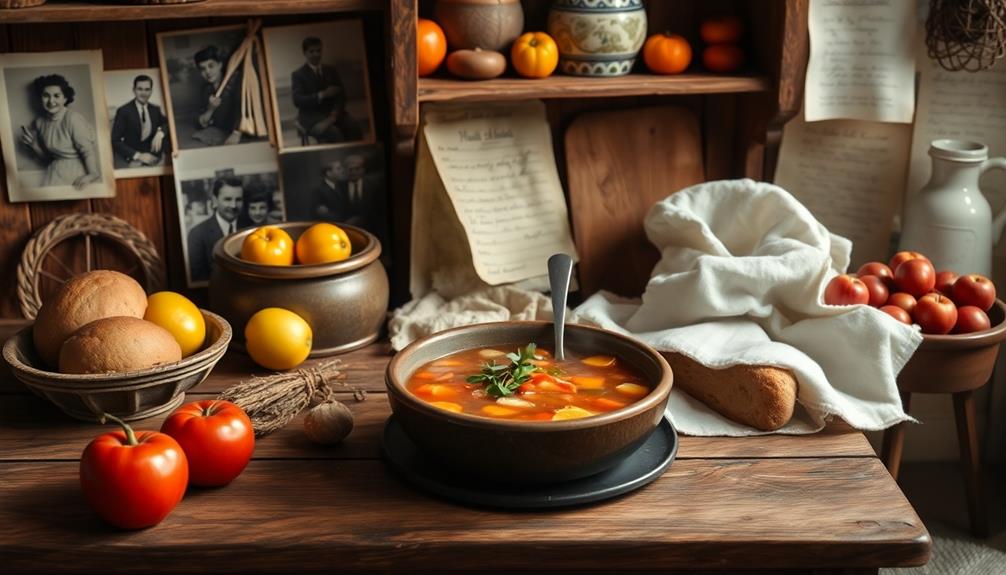
While you mightn't realize it, the flavors and aromas of your childhood can evoke powerful feelings of nostalgia, transporting you back to cherished moments. The taste and smell of familiar dishes, such as agnolotti's rich fillings, often trigger vivid emotional memories, reminding you of family gatherings and special occasions.
Think of your grandmother's secret recipe or the scent of freshly baked cookies; each bite can take you back in time.
Preparing and sharing traditional meals not only enhances these nostalgic feelings but also connects you to your cultural heritage. Celebratory foods, like those served during holidays, carry an emotional weight, as they symbolize significant life events and shared experiences with loved ones.
Moreover, the olfactory system is uniquely linked to the brain's emotional centers, making smell a potent trigger for recalling past moments. When you gather around a table, surrounded by the rich aromas of communal meals, you foster a sense of belonging, amplifying the nostalgic impact of your culinary experiences.
Every taste and smell weaves together a tapestry of memories, reminding you of where you come from and who you've shared those moments with.
Contextual Influences on Memory
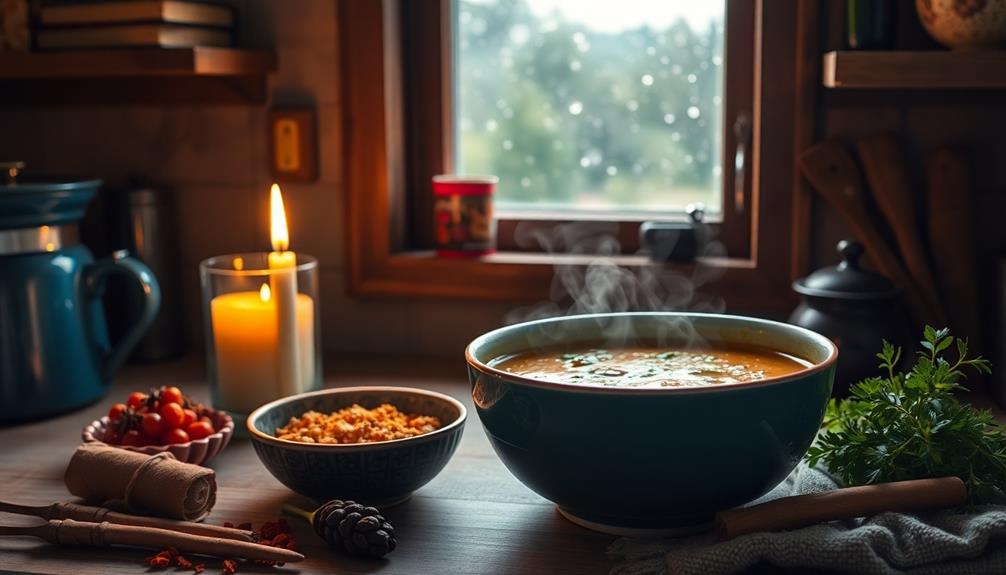
Memories tied to culinary experiences are often shaped by the context in which they occur. When you think back to meals shared with loved ones, the setting—like a cozy kitchen or a festive dining room—plays a vital role. These specific situations enhance strong memories, making them richer and more vibrant.
For instance, the aroma of a hearty Caldeirada simmering on the stove can evoke images of family gatherings by the seaside. The emotional context around food preparation and consumption adds layers to your recollections, whether it's the laughter of family or the warmth of a holiday gathering.
Recreating a beloved dish can feel challenging if you strip it of its original context. You might find that the flavors lack the same emotional weight without the presence of those special people or the atmosphere that once surrounded them. Food memories often represent broader themes of love and nurturing, symbolizing the connections you share with others over meals.
Additionally, factors like the ambiance of a dining environment or cultural food rituals shape how you form and recall these memories. It's through these unique contexts that your culinary experiences become deeply embedded in your mind, evoking powerful feelings long after the meal has ended.
Positive Associations in Business
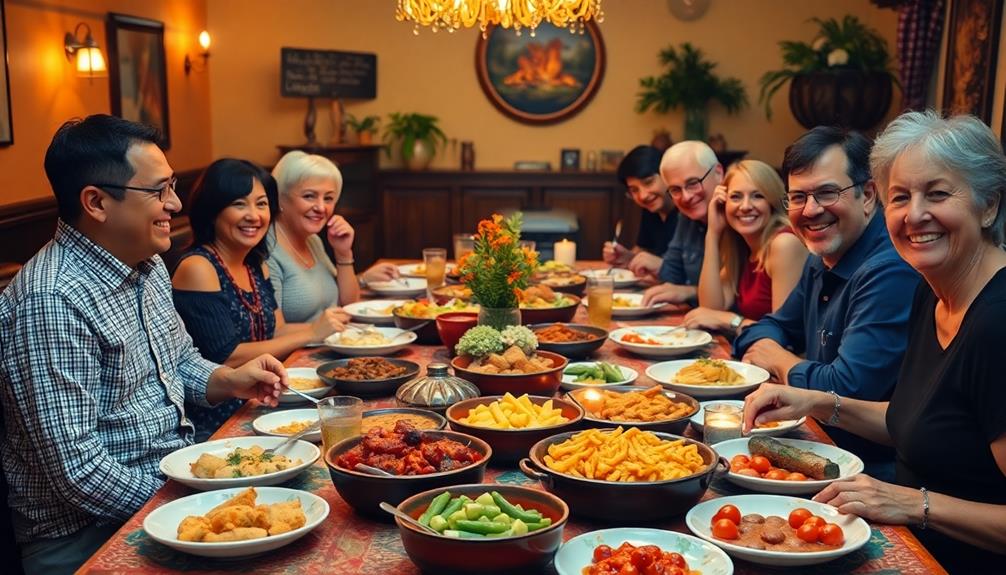
Creating positive associations in business can considerably impact brand perception and client relationships. When you incorporate gourmet snacks or even candy into your interactions, you activate your clients' brain reward mechanisms, enhancing motivation and leaving a memorable experience. This strategic approach can set your organization apart in a competitive market.
For instance, offering a delightful Turkey Sandwich (For Leftovers) can evoke nostalgic feelings and create a warm atmosphere, making meetings more enjoyable.
- Boost employee morale with thoughtful snack gifts
- Strengthen client relationships through shared culinary experiences
- Create lasting emotional connections at celebrations
- Enhance team spirit during events with gourmet treats
- Improve overall client satisfaction with customized options
By providing high-quality snacks during meetings or events, you foster positive associations that resonate with both clients and employees. This simple gesture can reinforce loyalty and engagement, making your clients feel valued.
Plus, it's a fun way to break the ice and spark conversations.
Incorporating food into your business strategies not only makes interactions more enjoyable but also cultivates a positive corporate culture that can lead to growth.
Mood Enhancement Through Chocolate
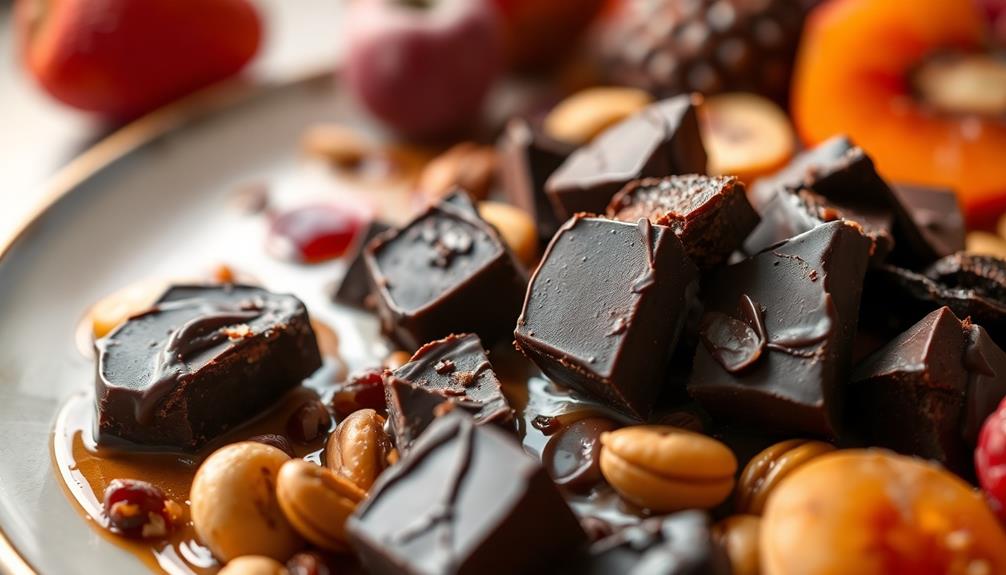
When you think about chocolate, it's hard not to feel a surge of happiness. Its unique chemical composition not only makes it delicious but also triggers emotional connections that many cultures cherish.
In the domain of comfort food, similar to how Red-Braised Pork Belly brings families together during festivals, chocolate often plays a central role in celebrations and special occasions.
Let's explore how chocolate enhances your mood and the significance it holds in various celebrations.
Chocolate's Chemical Composition
For centuries, chocolate has captivated people not just for its taste but also for its remarkable ability to uplift mood. Its unique chemical composition plays a vital role in this phenomenon. When you indulge in chocolate, compounds like phenylethylamine and theobromine mimic endorphins, enhancing your feelings of pleasure.
The sugar content activates your brain's reward mechanisms, releasing dopamine—another key player in promoting happiness. Notably, certain foods, like Mushroom Masala, can also evoke strong sensory memories and emotional connections, highlighting the profound impact of flavors on our psyche.
Here are some fascinating facts about chocolate's mood-enhancing properties:
- Contains phenylethylamine, which can elevate mood.
- Triggers dopamine release, enhancing pleasure.
- Reduces stress hormones like cortisol for relaxation.
- Dark chocolate's flavonoids improve brain function.
- Tasting chocolate creates lasting positive memories.
Notably, while many enjoy chocolate, some might experience taste aversion due to its richness. However, the overall benefits often outweigh such reactions.
Emotional Connections to Chocolate
Throughout history, chocolate has forged deep emotional connections for many, often serving as a source of comfort and joy. When you indulge in chocolate, it can take you back to childhood, evoking memories of special moments like birthday parties or family gatherings. This connection isn't just sentimental; it's rooted in science.
Chocolate consumption can alleviate negative emotions and enhance your mood by promoting dopamine release, which mirrors the feel-good effects of opioids. Additionally, flavors associated with traditional treats, such as Txakoli's high acidity, can accentuate the experience of indulgence, creating a multifaceted sensory memory.
The rich flavor and aroma of chocolate work wonders to lower stress levels, creating a pleasurable sensory experience. Each bite activates your brain's reward mechanisms, reinforcing its association with happiness and comfort. These positive experiences contribute to long-term memories, making chocolate a powerful trigger for nostalgia.
With so many varieties of chocolate snacks available, you're bound to find one that resonates with your personal experiences. Whether it's a creamy milk chocolate bar or a rich dark truffle, each type can bring a wave of emotional uplift.
Cultural Significance of Chocolate
Chocolate holds a cherished place in cultures around the world, often symbolizing love, celebration, and comfort. Its powerful emotional impact is evident in how it influences your mood and creates lasting memories. When you indulge in chocolate, you're not just enjoying a treat; you're experiencing a sensory journey that can uplift your spirits.
This experience can be compared to enjoying traditional Korean dishes like bulgogi or bibimbap, which also evoke strong memories and emotions through their rich flavors and cultural significance.
- Chocolate promotes dopamine release, mimicking opioids.
- Its taste and aroma forge positive food memories.
- Chocolate is central to celebrations, enhancing emotional connections.
- It effectively lowers stress levels, providing comfort.
- Varieties of chocolate offer diverse flavor experiences.
These aspects show why chocolate is more than just a food; it's a cultural phenomenon that enhances your emotional well-being.
Whether you're sharing a box of chocolates on a special occasion or treating yourself after a long day, chocolate evokes feelings of joy and nostalgia.
It's this unique ability to alleviate negative emotions while creating powerful emotional associations that makes chocolate a beloved staple in celebrations worldwide.
Strategies for Engaging Snack Provision
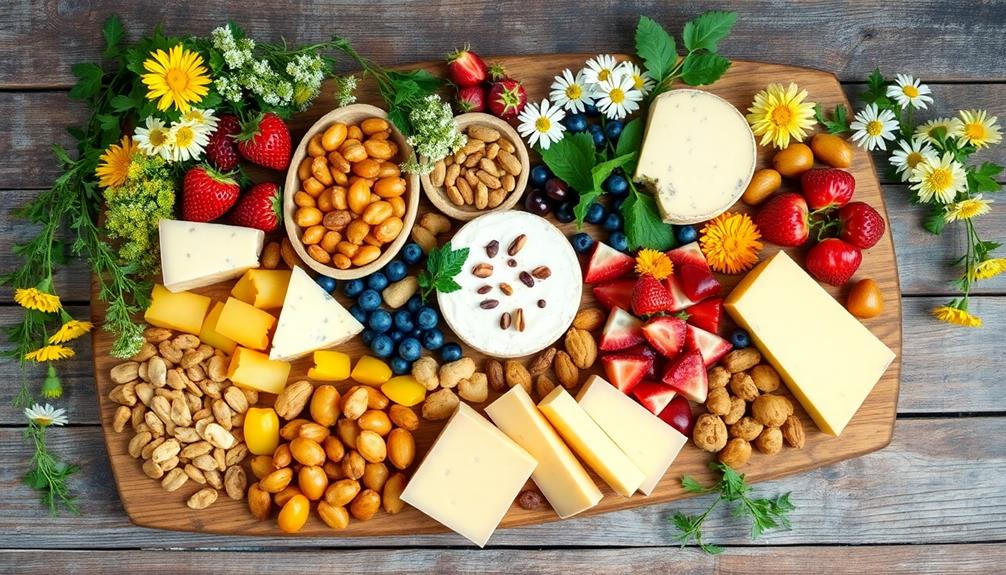
Often, the snacks you choose for events can make or break the overall experience for your attendees. By focusing on engaging snack provision, you can create lasting impressions that enhance your brand's reputation.
Selecting high-quality snacks is vital; they not only satisfy hunger but also trigger positive sensory memories. For example, offering unique treats like Khanom Tan can evoke delightful memories associated with Thai festivals. You might want to partner with providers known for their reliability and consistency. This guarantees that every snack served is up to your standards, reinforcing positive associations with your brand.
Customization options can further elevate the experience. Tailoring snacks to fit specific events or client preferences adds a personal touch that attendees appreciate.
Streamlined ordering and delivery processes are also essential. When you take care of logistics efficiently, you can focus on building relationships with your clients without distractions.
Funky Chunky, for example, offers a diverse range of gourmet snacks that cater to various occasions. By incorporating these certain actions into your event planning, you not only engage your attendees but also foster loyalty.
Cultural Significance of Food
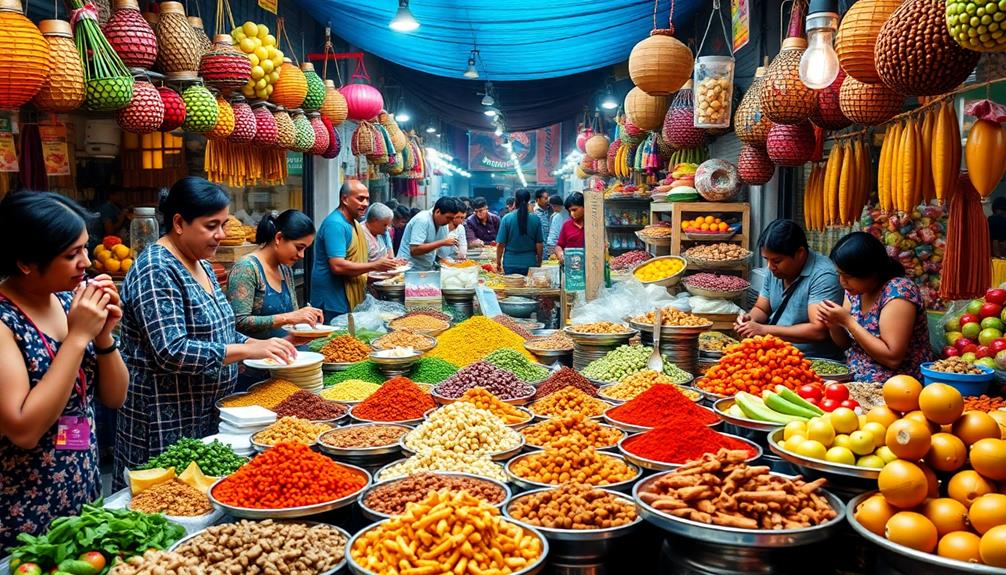
The snacks you choose not only enhance events but also reflect deeper cultural significance. Food is an essential part of cultural practices, often commemorating significant events through shared meals. These feasting traditions create an abundance of food that strengthens cultural bonds and reinforces memories of communal experiences.
- Candy that reminds you of childhood celebrations
- Dishes symbolizing heritage during holidays
- Traditional meals shared during family gatherings
- Flavors that evoke stories of your ancestors
- Recipes passed down through generations
When you indulge in nostalgic food experiences, like a beloved candy, it can transport you back to treasured moments, bridging the past and present.
Cultural rituals frequently incorporate food to honor heritage, fostering connections among family and friends during celebrations. Specific dishes often symbolize broader themes, reflecting historical narratives and familial legacies that contribute to your identity.
Engaging with these culinary traditions not only satisfies your taste buds but enriches your understanding of your culture. As you savor each bite, remember that you're participating in a rich tapestry of shared memories, emotions, and connections that define who you are.
The Role of Smell in Flavor
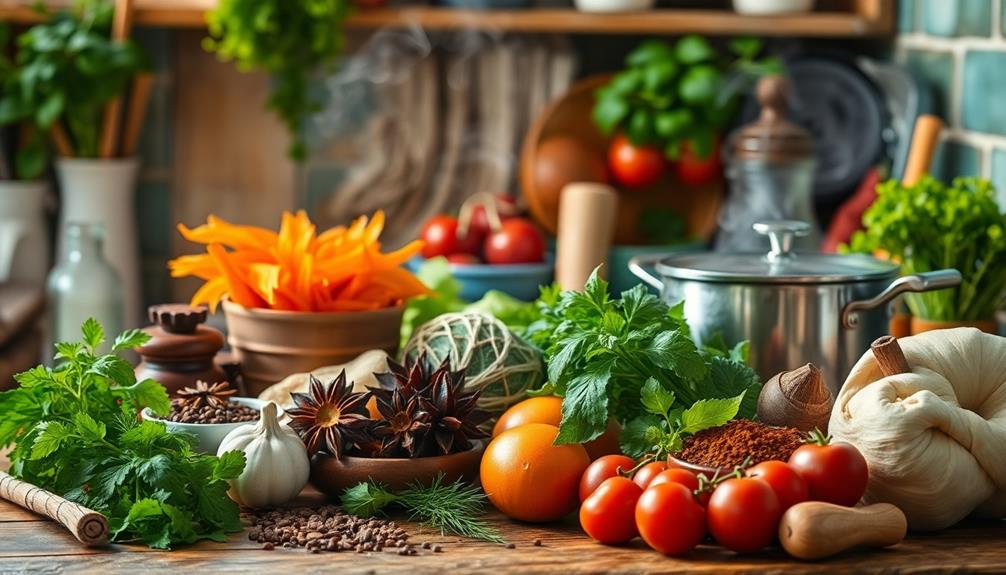
When you savor a meal, you mightn't realize how much smell shapes your flavor experience.
About 80% of what you taste actually comes from your sense of smell, highlighting the connection between these two chemical senses.
This interplay allows you to appreciate unique flavor combinations, making each bite a richer experience.
Smell Enhances Flavor Perception
Enhancing your dining experience, smell plays a pivotal role in flavor perception. When you take a bite of your favorite dish, it's not just the taste that delights you; it's the aroma that truly elevates the flavor. Your olfactory system, with over 12 million receptors, detects various molecules and considerably influences how you experience taste.
- Smell and taste work together to create a unique flavor profile.
- Your brain uses about 450 types of smell receptors to differentiate flavors.
- Aromas can trigger vivid memories and emotions, enhancing the overall experience.
- The complexity of flavors is better appreciated when paired with enticing smells.
- Homemade dishes often have richer aromas, which enhance their perceived flavor.
Without the sense of smell, your perception of flavor would be drastically diminished. In fact, the combination of taste, texture, temperature, and smell is what makes culinary enjoyment so complex.
The next time you savor a meal, pay attention to how the smells enhance your overall experience, making each bite a delightful journey for your senses.
Chemical Senses Interconnection
Amid the delightful symphony of flavors, the interconnection between smell and taste plays an important role in shaping your culinary experiences. Your olfactory system, equipped with over 12 million receptors, detects and interprets a wide array of aromas, enhancing your overall flavor perception.
Flavor isn't just about taste; it's a complex blend of taste, texture, temperature, and smell, creating a rich multi-sensory experience.
When you take a bite, the 450 types of smell receptors in your nose work in harmony, contributing considerably to how you perceive food. This is why homemade dishes often evoke stronger emotional memories than store-bought ones; the unique smell profiles trigger your olfactory system, encoding those experiences deeply in your mind.
The close proximity of the olfactory bulb to the hippocampus is vital, as it allows specific smells to evoke vivid emotional memories. The intricate combinations of smell molecules shape the distinct flavors you savor, highlighting the importance of olfactory input.
Unique Flavor Combinations
Exploring unique flavor combinations reveals how essential smell is in crafting memorable culinary experiences. When you savor a dish, you're not just tasting; you're engaging your olfactory senses, which play a pivotal role in flavor perception. With over 12 million olfactory receptors, your nose can detect a wide range of smell molecules, enhancing each bite.
Here are some intriguing aspects of how smell influences flavor:
- The interplay of taste, texture, and temperature
- The role of 450 different types of smell receptors
- Why homemade meals often taste richer than store-bought
- How smell enhances flavor perception
- The connection between smell and emotional memory
When you combine various smell molecules, you create unique flavor profiles that elevate your dining experience. The nuanced smell of fresh herbs or spices can transform a simple dish into something extraordinary.
This is why cooking with fresh ingredients often leads to more complex sensory experiences. Ultimately, the olfactory bulb's close connection to the brain's emotional centers means that the flavors you enjoy today could evoke fond memories for years to come.
Evolutionary Benefits of Taste Memory

Taste memory offers significant evolutionary benefits that have shaped our survival instincts. When you experience a negative reaction to a particular food, your brain forms a taste aversion, helping you remember to avoid that food in the future. This mechanism is essential for survival, as it prevents you from consuming harmful substances that could lead to illness or discomfort.
On the flip side, the emotional memory associated with positive food experiences enhances your enjoyment of meals. By recalling flavors linked to happiness or comfort, you're more likely to seek out and consume beneficial foods. This connection not only promotes overall well-being but also fosters a sense of nostalgia that can enhance your culinary experiences.
Interestingly, culinary innovations take advantage of these evolutionary ties between taste and memory. By creating familiar flavors that evoke strong emotional responses, chefs can tap into your taste memories to create memorable dining experiences.
The close proximity of the olfactory nerve to the hippocampus further strengthens the encoding of these emotional memories, especially those related to food. Ultimately, taste memory plays an essential role in guiding your food choices, ensuring your survival and enhancing your enjoyment of life. Our ability to remember the taste and texture of certain foods also contributes to our aversions and preferences. Understanding food texture aversions can be attributed to our past experiences and memories associated with certain types of textures. This highlights the intricate relationship between our senses and memories in shaping our relationship with food. The neuroscience behind texture aversions reveals that our brains process the textures of food based on past experiences and emotional associations. These memories can influence whether we find a particular texture pleasurable or off-putting. The interplay between our senses and memories not only impacts our individual food preferences but also contributes to the cultural and regional diversity of culinary traditions.
Frequently Asked Questions
What Triggers Sensory Memory?
Sensory memory gets triggered by strong stimuli from your senses, particularly taste and smell, which evoke emotions and memories. When you encounter familiar scents or flavors, they often transport you back to significant moments in your life.
Why Do Certain Things Trigger Memories?
Have you ever wondered why certain things spark memories? It's all about associations your brain makes. Emotional connections and experiences shape your recollections, making them vivid whenever you encounter specific sights, sounds, or smells again.
How Does Food Evoke Memories?
Food evokes memories because it connects you to past experiences through taste and smell. When you savor a familiar dish, those sensations can transport you back to cherished moments, reigniting emotions tied to those memories.
What Is It Called When a Taste Triggers a Memory?
When a taste triggers a memory, it's called gustatory-evoked memory. You experience this connection between flavors and emotions, allowing specific tastes to transport you back to vivid moments from your past, enriching your experiences.
Conclusion
In exploring how certain foods trigger sensory memories, it's clear that the emotional power of taste and smell intertwines with our experiences. Imagine a warm cookie fresh from the oven, instantly transporting you to childhood. This connection isn't just personal; it's universal. By understanding the neuroscience behind these memories, you can leverage this knowledge to create deeper connections, whether in your culinary adventures or business strategies. Ultimately, food isn't just sustenance; it's a gateway to nostalgia and emotion.
